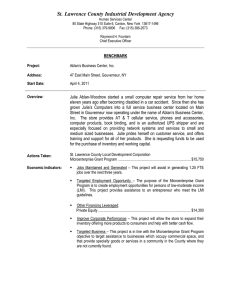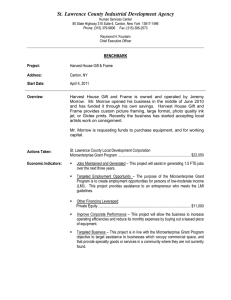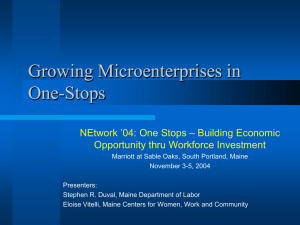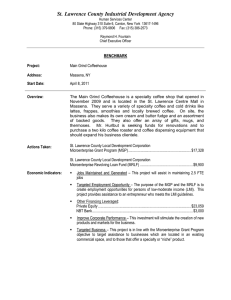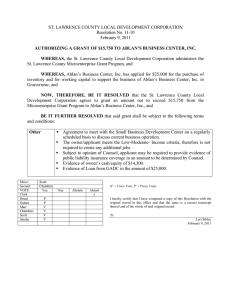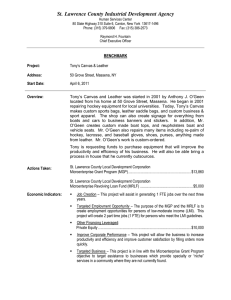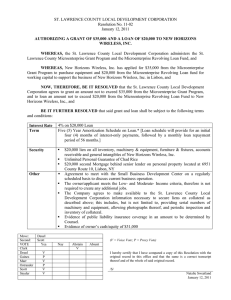Small Business and Microenterprise as an Opportunity- and Asset-Building Strategy
advertisement
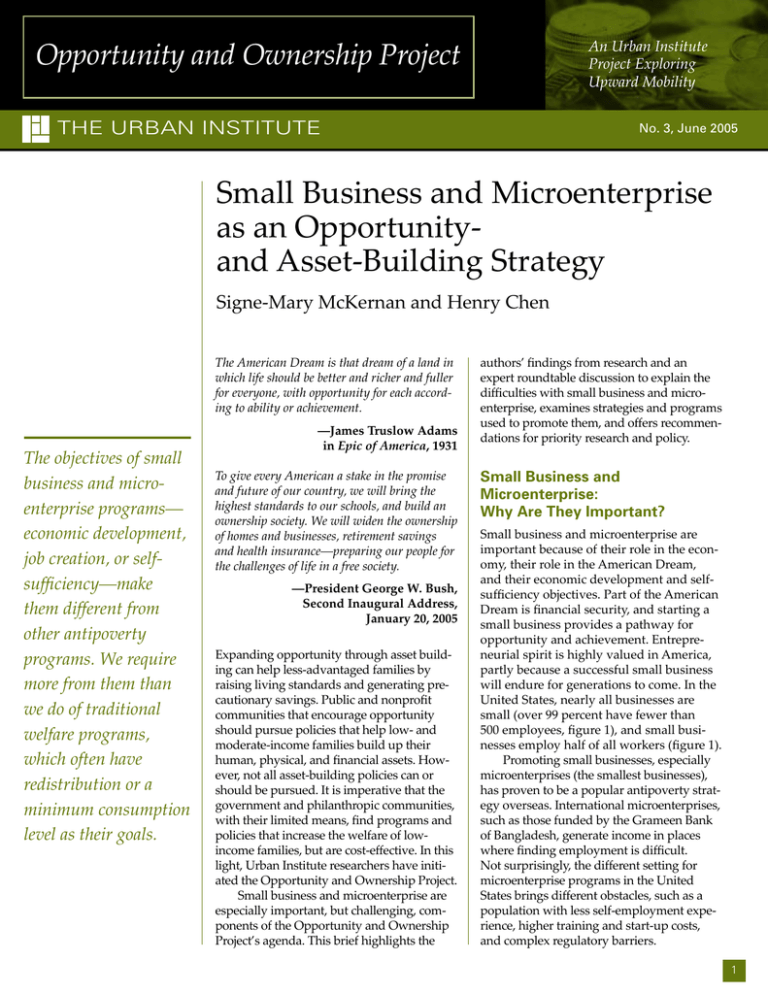
An Urban Institute Project Exploring Upward Mobility Opportunity and Ownership Project THE URBAN INSTITUTE No. 3, June 2005 Small Business and Microenterprise as an Opportunityand Asset-Building Strategy Signe-Mary McKernan and Henry Chen The American Dream is that dream of a land in which life should be better and richer and fuller for everyone, with opportunity for each according to ability or achievement. The objectives of small business and microenterprise programs— economic development, job creation, or selfsufficiency—make them different from other antipoverty programs. We require more from them than we do of traditional welfare programs, which often have redistribution or a minimum consumption level as their goals. —James Truslow Adams in Epic of America, 1931 To give every American a stake in the promise and future of our country, we will bring the highest standards to our schools, and build an ownership society. We will widen the ownership of homes and businesses, retirement savings and health insurance—preparing our people for the challenges of life in a free society. —President George W. Bush, Second Inaugural Address, January 20, 2005 Expanding opportunity through asset building can help less-advantaged families by raising living standards and generating precautionary savings. Public and nonprofit communities that encourage opportunity should pursue policies that help low- and moderate-income families build up their human, physical, and financial assets. However, not all asset-building policies can or should be pursued. It is imperative that the government and philanthropic communities, with their limited means, find programs and policies that increase the welfare of lowincome families, but are cost-effective. In this light, Urban Institute researchers have initiated the Opportunity and Ownership Project. Small business and microenterprise are especially important, but challenging, components of the Opportunity and Ownership Project’s agenda. This brief highlights the authors’ findings from research and an expert roundtable discussion to explain the difficulties with small business and microenterprise, examines strategies and programs used to promote them, and offers recommendations for priority research and policy. Small Business and Microenterprise: Why Are They Important? Small business and microenterprise are important because of their role in the economy, their role in the American Dream, and their economic development and selfsufficiency objectives. Part of the American Dream is financial security, and starting a small business provides a pathway for opportunity and achievement. Entrepreneurial spirit is highly valued in America, partly because a successful small business will endure for generations to come. In the United States, nearly all businesses are small (over 99 percent have fewer than 500 employees, figure 1), and small businesses employ half of all workers (figure 1). Promoting small businesses, especially microenterprises (the smallest businesses), has proven to be a popular antipoverty strategy overseas. International microenterprises, such as those funded by the Grameen Bank of Bangladesh, generate income in places where finding employment is difficult. Not surprisingly, the different setting for microenterprise programs in the United States brings different obstacles, such as a population with less self-employment experience, higher training and start-up costs, and complex regulatory barriers. 1 An Urban Institute Project Exploring Upward Mobility OPPORTUNITY AND OWNERSHIP FIGURE 1. Distribution of Firms by Firm Size and Percent of Employees 60 Percent of firms Percent of employees Percent of employees, firms 50 50.1 47.7 40 30 20 18.0 17.7 14.3 12.4 10.9 10 4.9 5.8 7.2 9.2 1.5 0 0 1–4 5–9 10–19 20–99 Number of employees 100–499 0.3 500+ Source: U.S. Small Business Administration, Office of Advocacy. 2004. "Private Firms, Establishments, Employment, Annual Payroll, and Receipts by Firm Size, 1988–2001." http://www.sba.gov/advo/stats/us_tot.pdf. (Accessed 6 October 2004.) The objectives of small business and microenterprise programs—economic development, job creation, and self-sufficiency— make them different from other antipoverty programs. We require more from them than we do of traditional welfare programs, which often have redistribution or a minimum consumption level as their goals. Small business and microenterprise programs, on the other hand, are potentially efficient ways of helping people help themselves. If the ownership society is to be expanded, small business and microenterprise are a natural, but not necessarily easy, place to start. Small Business and Microenterprise Have a Narrow Target Population The target populations of small business and microenterprise programs differ from those of other antipoverty and asset-building strategies in ways that complicate the design of subsidies. Unlike the Earned Income Tax Credit (EITC), food stamps, or education programs, which cover a broad population, small business and microenterprise programs target a narrower and more elusive group interested in selfemployment or entrepreneurship. Only 11 percent of households own a small business (4 percent own businesses with 0 or 1 employees and 7 percent own businesses 2 with 2 to 499 employees, table 1). In some cases, small business programs do not target individuals at all, but rather aim to develop specific communities (see for example the HUBZone program in table 2). Some question small business subsidy programs because most recipients are not disadvantaged, but the Small Business Administration has a mix of programs with some, such as the (8)a Business Development Program, targeting disadvantaged groups (table 2). The debate comes from the tension between the Small Business Administration’s emphasis on economic (or entrepreneurial) development and the presumption that government programs should foster self-sufficiency. Targeting potentially successful entrepreneurs for economic development, rather than the disadvantaged for self-sufficiency, makes it more likely that government subsidies go to recipients who could have received private funding elsewhere. Most small business owners in the United States are male, white, hold a high school diploma or higher, and have moderate incomes (table 3). What Subsidies Are Available to Small Business and Microenterprise? The federal government assists small businesses through 55 programs (table 4). (The An Urban Institute Project Exploring Upward Mobility OPPORTUNITY AND OWNERSHIP TABLE 1. Incidence of Privately-Held Business Ownership by Household Net Worth, 1998 Self-employed owner (0 or 1 employees) Net worth of households All households Less than 50,000 50,000–99,999 100,000–249,999 250,000–499,999 500,000–999,999 1,000,000–2,499,999 2,500,000–4,999,999 5,000,000–9,999,999 10,000,000 or More Small business manager (2 to 499 employees) (millions) % of group (millions) % of group 4.39 0.80 0.78 1.29 0.78 0.41 0.19 0.10 0.03 0.02 4.28 1.79 5.33 6.10 6.27 7.24 6.91 9.42 6.62 8.33 7.24 0.99 0.60 1.26 1.62 1.38 0.78 0.35 0.19 0.08 7.06 2.24 4.11 5.98 12.95 24.25 28.52 34.19 42.24 37.25 Source: Haynes and Ou 2002. Table 3. Small Business Administration plays the largest role with more than 30.) A closer look at the costs associated with 10 of the Small Business Administration programs suggests that the SBA spent well over $340 million in small business subsidies in fiscal year 2002 (table 2). Government is an important source of funding for microenterprise programs, though this source may be less secure in the future. The combined annual operating budget of all responding microenterprise programs totaled $111 million in fiscal year 2000, with 60 percent of funding coming from government sources (figure 3). The Small Business Administration’s Microloan Program, which lent almost $33 million to 2,400 entrepreneurs in fiscal year 2004, is targeted for termination (Olson 2005). The Small Business Administration did not request funds for its Microloan Program in 2005 (table 2). Foundations also provide microenterprise development funding. The Ford Foundation and the Charles Stewart Mott Foundation provided a total of $41 million between 1983 and 1999 (table 5), approximately 11 percent of the total funding for microloan programs according to Else and Gallagher (2000). What Strategies Are Used to Subsidize Small Business and Microenterprise? Given that we value small business and microenterprise in the United States, what strategies should we use to promote them? The strategies used depend on the program’s objective: economic development and job creation versus self-sufficiency— two distinct objectives that require different strategies to achieve. However, many programs fail to distinguish between the two objectives and attempt both. The Small Business Administration supports both objectives, though most government subsidies appear geared toward promoting economic development and job creation. With this goal, programs and subsidies target the potentially successful entrepreneur who can create jobs and improve a community’s economy. Although the subsidies don’t go directly to disadvantaged groups, proponents argue that the benefits of economic development trickle down to low-income households. The main strategies for promoting economic development and job creation through small business are (1) subsidizing the cost of financing for small businesses and (2) assisting small businesses with government procurement. In fiscal year 2002, the SBA spent roughly $208 million in programs and subsidies geared toward economic development, compared with roughly $132 million in programs and subsidies geared toward selfsufficiency, according to the groupings we present in table 2. Though most microenterprise programs cite economic development (83 percent) among their goals (Aspen Institute 2002), their primary goal is promoting the second objective: self-sufficiency. With this goal, programs and subsidies target business ownership, often promoting it among 3 OPPORTUNITY AND OWNERSHIP An Urban Institute Project Exploring Upward Mobility TABLE 2. A Selection of Small Business Administration Assistance Programs Program description Performance measure FY 2002 actual Economic development Financing 7(a) Loan Programa The 7(a) Loan Program is SBA’s primary business loan program to help small businesses that face barriers to obtaining credit. These loans can be used to purchase inventory, facilities, or capital equipment. The maximum loan is $2 million. Loan subsidy cost estimate (000s) $129,094 504 Loan Program The 504 Loan Program provides growing businesses with long-term, fixedrate financing for major fixed assets, such as land and buildings. Program cost estimate (000s) $15,236 Small Business Investment Company The Small Business Investment Company program fills the gap between the availability of venture capital and the needs of start-up and growing small businesses. Program cost estimate (000s) $15,286 Government contracting and entrepreneurial development 8(a) Business Development Program The 8(a) Business Development Program helps firms owned by disadvantaged individuals enter and succeed in the economic mainstream. Assistance includes access to sole source and limited competition federal contract opportunities. Program cost estimate (000s) $40,847 HUBZone Program HUBZone encourages economic development in historically underutilized business zones—”HUBZones”—through the establishment of preferences. Program cost estimate (000s) $6,294 Small Business Innovation Research Through the award of research and development assistance grants and contracts, Small Business Innovation Research promotes the flow of innovative products and services from small businesses to the federal and commercial markets. Program cost estimate (000s) $1,396 Total spent on economic development programs (000s) $208,153 Self-sufficiency Financing The Microloan Program provides very small loans ($35,000 maximum) to newly established or growing small business concerns through community-based lenders. Loan subsidy cost estimate (000s) $1,153 SCORE SCORE volunteers provide face-to-face counseling to help clients set realistic business expectations through development of sound business and marketing plans, management advice, and guidance. Program cost estimate (000s) $13,271 Small Business Development Centers Small Business Development Centers is SBA’s largest management and technical assistance program. Program cost estimate (000s) $100,150 Women’s Business Centers The Women’s Business Centers program provides in-depth, long-term training, counseling, mentoring, access to capital, and encouragement to start-up and existing women-owned small businesses. Program cost estimate (000s) $17,450 Microloan Programb Training Total spent on self-sufficiency programs (000s) $132,024 Total (000s) $340,177 Source: U.S. Small Business Administration 2003. “SBA Budget Request and Performance Plan, FY 2004.” a. The 7(a) Loan Program provided $9.4 billion in loans in 2002, some of which were small loans (less than $35,000), which might be categorized as promoting self-sufficiency rather than economic development. In FY 2002, 64 percent of 7(a) loans were less than $150,000. b. The SBA’s budget did not request funds for the Microloan Program in 2005. 4 An Urban Institute Project Exploring Upward Mobility TABLE 3. Characteristics of Business Owners, 1998 Self-employed owner (0 or 1 employees) Small business manager (2 to 499 employees) Age of household head Younger than 35 35–44 45–54 55–64 65–74 75 and older 14.7% 21.3% 31.1% 17.4% 12.2% 3.2% 15.1% 33.7% 27.7% 15.2% 6.9% 1.4% Race of household head White Nonwhite 85.7% 14.3% 91.7% 8.3% Gender of household head Male 89.6% 94.2% Education of household head Less than high school High school diploma only Some college College degree or more 7.9% 24.7% 21.3% 46.1% 7.0% 21.7% 23.3% 48.0% Income of household Less than 10,000 10,000–24,999 25,000–49,999 50,000–99,999 100,000 or more 5.4% 16.4% 34.4% 31.2% 12.5% 2.1% 8.8% 24.6% 36.6% 27.9% Source: Haynes and Ou 2002. Table 5. less-advantaged populations to keep them out of poverty and off welfare programs. Strategies for promoting self-sufficiency involve far more training than strategies geared toward economic development (table 2 and figure 2). Only 4 percent of U.S. microenterprise programs provide lending alone, 63 percent provide both lending and training, and 33 percent provide training alone (figure 2). Do Small Business Grants and Microenterprise Programs Work? A brief look at the research on small business and microenterprise suggests considerable uncertainty about the impacts of small business grants and microenterprise programs on economic development and selfsufficiency. Anecdotal evidence and TABLE 4. Federal Small Business Assistance Programs, by Agency Agency Number of Programs Small Business Administration Department of Agriculture Department of Defense Department of Energy Department of Housing and Urban Development Department of Transportation Department of Labor 38 7 4 3 1 1 1 Total 55 Source: U.S. Senate Committee on Small Business and Entrepreneurship, “Federal Resources.” OPPORTUNITY AND OWNERSHIP case studies suggest that small business and microenterprise programs may increase entrepreneurship (Audretsch, Weigland, and Weigland 2002) and revitalize communities (Siek 2002), but these studies are not representative. Longitudinal analysis of program participants suggests that microenterprise programs increase income (Clark et al. 1999; Himes and Servon 1998), increase assets (Raheim 1996; Himes and Servon 1998), and decrease enrollment in transfer programs (Raheim 1996). While research studies such as these are informative, they are not persuasive—they rarely control for the possibility that those who receive the subsidy are more successful than those who do not, or that those who receive the subsidy might have done well without it. This type of selection bias needs to be addressed, as shown in Wallsten’s 2000 study of the Small Business Innovation Research grant program. Wallsten finds that a more naïve regression model that does not control for selection effects shows a positive relationship between grants and employment. However, the relationship does not stem from grants increasing employment, but from firms with more employees receiving grants. The one U.S. microenterprise program evaluation that controlled for selection bias (through an experimental design) found no increase in employment or wage rates, but did find decreases in the length of unemployment spells (Benus et al. 1995). A study underway may make additional progress in evaluating microenterprise while controlling for selection bias. As part of Project GATE, a microenterprise initiative, IMPAQ International and its partners will use an experimental design to evaluate whether the microenterprise initiative effectively promotes self-employment, generates new businesses, and promotes community development (IMPAQ International 2003). Conclusions and Recommendations Small business and microenterprise are an important part of the Amer5 An Urban Institute Project Exploring Upward Mobility OPPORTUNITY AND OWNERSHIP FIGURE 2. Services Offered by Microenterprise Programs, FY 2000 Lending Only 4% Training Only 33% Lending and Training 63% Source: Aspen Institute 2002 Directory of U.S. Microenterprise Programs. ican Dream, and they create more economic development and selfsufficiency than redistributing income to poorer households or meeting a minimum consumption level do. However, subsidies for small business and microenterprise are contentious because they are directed toward a narrow segment of the population that is not necessarily disadvantaged. Based on the findings outlined in this brief and the suggestions of expert roundtable participants, we recommend six broad directions for future small business and microenterprise research, funding, and policymaking. TABLE 5. Microenterprise Development Funding Funder Total funding Foundations Ford Charles Stewart Mott $28.9 million 1983–1999 $12.1 million 1983–1999 Yearly average $1.7 million $807, 600 Federal Government Small Business Administration Department of Health and Human Services Job Opportunities for Low-Income Individuals Demonstration Partnership Program Office of Refugee Resettlement Department of Treasury: CDFI Department of Housing and Urban Development Department of Agriculture Department of Labor $23.8 million $3.3 million $19.6 million $25.8 million 1990–1998 1987–1992 1991–2002 1996–1999 $20.1 million $15.8 million $5.2 million 1996–1998 $8.1 million 1997–1999 $5.3 million 1994, 1997 $2.6 million Total $363.8 million Source: Else and Gallagher 2000. 6 Period $209.2 million 1992–1999 $26.1 million $4.0 million $812,500 $1.6 million $6.5 million $57.5 million Future research should evaluate whether small business subsidies and microenterprise programs increase self-sufficiency or economic development and the effectiveness of the two approaches for improving the wellbeing of low-income families. Does subsidizing low-income business ownership (the self-sufficiency approach) or subsidizing the successful entrepreneur who may create additional jobs (the economic development approach) better improve the well-being of low-income families? Within the two approaches, which strategies work best? Is training key, or financing (lending), or the combination of the two? What are the gains from targeting specific groups and geographic regions? Put another way, does targeting subsidies to disadvantaged populations weaken the program’s ability to promote economic development? If so, by how much? Policies and programs for small business and microenterprise should consider the self-sufficiency and economic development objectives separately. The rationale and goals for programs to increase self-sufficiency should be formulated and evaluated separately from those of programs to increase economic development. Many programs blur the two objectives and try to achieve both. This brief has tried to group programs and subsidies according to these strategies (table 2) but the separation is somewhat forced because of the dual goals of many programs. Better separation will clarify objectives, better target populations, and lead to more effective evaluation of the targeting, costs, and benefits of each type of program. Foundations and policymakers can improve evaluation by creating standards and accreditation, and requiring that grantees collect data for evaluation by outside evaluators. For instance, donors could require that microenterprise programs participate in Microtest—a national data collection system that would ensure comparability of data quality and availability across programs. Currently, few programs report data and often those that do report are the most successful, creating additional An Urban Institute Project Exploring Upward Mobility FIGURE 3. Microenterprise Program Funding Sources Income from Program Activities 12% Private Sources 27% Other Sources 3% Local Government 6% Federal Government 36% State Government 16% Source: Aspen Institute 2002 Directory of U.S. Microenterprise Programs. selection bias. As a second example, evaluation data could be collected through trade associations or from programs seeking accreditation. Metrics for measuring success should also be assessed to improve evaluation. Metrics such as the number of business start-ups, for example, need to be considered carefully. Perhaps the best possible outcome for training is learning that one should not start a business or should close a business. Metrics are also needed to assess community effects, which are especially important when economic development is an objective. Community effects, such as increased employment in the community, may appear only over time and can be difficult to measure. Broad, consistent metrics (for example, measures of self-sufficiency or economic development), in addition to program-specific ones, will allow for better comparison across programs. Researchers, philanthropists, and policymakers should think beyond subsidizing small business and microenterprise. We should also examine the barriers that limit at-risk groups from starting and maintaining businesses, such as asset tests in means-tested welfare programs and tax policies affecting microenterprises. In addition, we should consider the wisdom of using small business as a strategy to improve the well-being of low-income families. Finally, small business and microenterprise subsidies should not be evaluated in isolation, but against other subsidies and programs with similar objectives. For example, does a dollar in subsidy to a microenterprise program increase self-sufficiency more than a dollar in the EITC or a housing subsidy? OPPORTUNITY AND OWNERSHIP Report. Washington, DC: Institute for Social and Economic Development. Haynes, George W., and Charles Ou. 2002. “A Profile of Owners and Investors of Privately Held Businesses in the United States, 1989– 1998.” Washington, DC: U.S. Small Business Administration, Office of Advocacy. Himes, Christina, and Lisa J. Servon. 1998. Measuring Client Success: An Evaluation of ACCION’s Impact on Microenterprises in the United States, U.S. Issues Series No. 2. Boston: Accion International. IMPAQ International, LLC. 2003. “Project GATE: Design Report.” http://www. doleta.gov/projectgate/htm/GATE %20 Design-2.cfm. (Accessed 18 March 2005.) Olson, Elizabeth. “Fears for a Program That Lends Just a Little.” New York Times. March 17, 2005. Raheim, Salome. 1996. “Micro-enterprise as an Approach for Promoting Economic Development in Social Work: Lessons from the Self-Employment Investment Demonstration.” International Social Work 39(1): 69–82. Siek, Stephanie. “Ethnic Market Fills Vacant Stores with Sights, Sounds of Home.” Bexley (Ohio) News. November 27, 2002, p. 21. U.S. Senate Committee on Small Business and Entrepreneurship. “Federal Resources.” http://sbc.senate.gov/democrat/financing. cfm. (Accessed 17 March 2005.) U.S. Small Business Administration. 2003. “SBA Budget Request and Performance Plan, FY 2004.” http://www.sba.gov/aboutsba/2004/ fy2004budget.pdf. (Accessed 17 March 2005.) Wallsten, Scott J. 2000. “The Effects of Government-Industry R&D Programs on Private R&D: The Case of the Small Business Innovation Research Program.” Rand Journal of Economics 31(1): 82–100. About the Authors References The Aspen Institute. 2002. 2002 Directory of U.S. Microenterprise Programs. Washington, DC: The Aspen Institute, Field Program. Audretsch, David B., Juergen Weigand, and Claudia Weigand. 2002. “The Impact of the SBIR on Creating Entrepreneurial Behavior.” Economic Development Quarterly 16(1): 32–38. Benus, Jacob M., Terry B. Johnson, Michelle Wood, Neelima Grover, and Theodore Shen. 1995. “Self-Employment Programs: A New Re-Employment Strategy, Final Report on the UI Self-Employment Demonstration.” Unemployment Insurance Occasional Paper 95-5. Washington, DC: U.S. Department of Labor. Clark, Peggy, Amy Kays, Lily Zandniapour, Enrique Soto, and Karen Doyle. 1999. Microenterprise and the Poor: Findings from the Self-Employment Learning Project FiveYear Survey of Microentrepreneurs. Washington, DC: The Aspen Institute. Else, John F., and Janice Gallagher. 2000. “An Overview of the Microenterprise Development Field in the U.S.” Institute for Social and Economic Development Research Signe-Mary McKernan is a senior research associate and economist at the Urban Institute. Dr. McKernan’s research examines credit and asset building for low-income families, and credit, asset building, welfare programs, and household events in economic well-being. Henry Chen is a research assistant at the Urban Institute. His research deals with employment and training, welfare programs, fatherhood and family structure, and the causes and effects of asset building for lowincome households. 7 THE URBAN INSTITUTE 2100 M Street, NW Washington, DC 20037 Nonprofit Org. U.S. Postage PAID Permit No. 8098 Ridgely, MD Address Service Requested For more information, call Public Affairs: 202-261-5709 or visit our web site, http://www.urban.org. To order additional copies of this publication, call 202-261-5687 or visit our online bookstore, http://www.uipress.org. Given the chance, many low-income families can acquire assets and become more financially secure. Conservatives and liberals increasingly agree that government’s role in this transition requires going beyond traditional antipoverty programs to encourage savings, homeownership, private pensions, and microenterprise. The Urban Institute’s Opportunity and Ownership Project held five roundtables in 2004 to explore these options. This policy brief series presents some of our findings, analyses, and recommendations. The authors are grateful to the Annie E. Casey Foundation for funding the roundtables and policy briefs and to the roundtable participants for their insightful comments. THE URBAN INSTITUTE The authors thank roundtable participants for excellent insight and recommendations and Robert Lerman and Charles Ou for excellent comments. 2100 M Street, NW Washington, DC 20037 Copyright © 2005 Phone: 202-833-7200 Fax: 202-293-1918 The views expressed are those of the authors and do not necessarily reflect those of the Urban Institute, its board, its sponsors, or other authors in the series. Permission is granted for reproduction of this document, with attribution to the Urban Institute.
